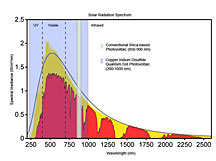- Number 298 |
- October 26, 2009
Nanoparticle breakthrough could improve solar cells

Precision-crafted nanoparticles could
enable photovoltaic cells to harness a
much bigger chunk of the sun’s energy.
(Click for larger, easier to read image.)
The sun may soon power many more homes and appliances, thanks to chemists at Idaho National Laboratory and Idaho State University. They have invented a way to manufacture highly precise, uniform nanoparticles to order. The technology, which won an R&D 100 Award this year, has the potential to vastly improve photovoltaic cells and further spur the growing nanotech revolution.
INL chemist Bob Fox and his ISU colleagues were looking for a better way to make semiconducting nanoparticles for solar cells. When the researchers introduced "supercritical" carbon dioxide — CO2 that behaves like both a gas and a liquid — to their reactions, they generated high-quality nanoparticles at low, energy-saving temperatures. And, surprisingly, the nanoparticles were incredibly uniform.
With subsequent tweaking, the team figured out how to make nanoparticles of prescribed sizes — anywhere from 1 to 100 nanometers — with unprecedented precision. Because the properties of nanoparticles are so strongly size-dependent, the implications of this breakthrough are vast.
The new methodology could lead to more efficient solar cells, for example. Photovoltaic cells generate electricity when incoming photons knock electrons loose from atoms of a semiconducting material. The energy required to free these electrons — called the band gap — is specific to each material and corresponds to a mere sliver of the sun's radiation spectrum. Lower-energy photons do nothing, and the extra punch of higher-energy photons is wasted as heat. This fact explains why the efficiency of most current cells maxes out around 20 percent.
But more of the sun's energy could be captured if semiconductor building blocks could be tuned to several specific wavelengths of light. The band gap of semiconducting nanoparticles changes greatly with size, so precise control of nanoparticle dimensions may make it possible to manufacture such building blocks from a single material. A photovoltaic cell made of such components could capture huge swathes of the solar energy spectrum.
Other, similar applications should soon appear on the horizon for the technology, which has been licensed by Precision Nanoparticles, Inc., of Seattle.
“The only thing limiting us at this point is our imagination,” Fox says.
Submitted by DOE's Idaho National Laboratory
